Samsung Galaxy Note Edge review: Innovation, experiment or gimmick?

Just because you can do something, should you? Samsung thinks so. Its second experimentally screened phone taps into its hardware R&D and production clout to offer something not many other companies can make, let alone bring to the public outside of a fuzzy proof of concept. And so, following the Galaxy Round, here's the Galaxy Edge. If you take the basic shape and concept, it's the spitting image of the curved-screen Youm prototype spied at CES a little less than two years ago. Now, though, it's a for-real smartphone you can buy. I've been testing it out in Japan, where it launched instead of the Note 4, although both the Note 4 and the Note Edge will eventually be available in the US. Fortunately, despite the unusual, (addictively stroke-able) curved screen, it still packs all of the good things that made the Note 4 such a strong choice. But bragging rights aside, is there enough of an argument for a curved screen? Should you just get the Note 4 anyway?
Hardware
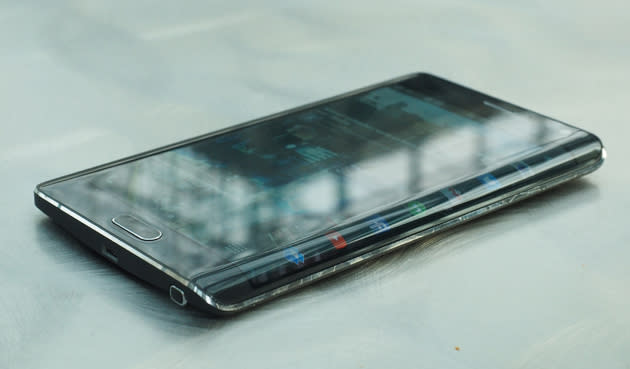
The Galaxy Note Edge grabs your attention. Its curves are subjective and divisive; my friends and colleagues have offered up reactions ranging from outright bemusement to adoration. The screen looks great, with the punchy contrast and sharpness that's been a Samsung flagship mainstay for years. We'll get back to that edge, but it's the headline part of a 5.6-inch Quad-HD+ display. ("Plus" here, in comparison to the Note 4, means an additional 160 rows of pixels.) This means a little chunk of extra screen makes the phone just less than 4mm wider, and around 2mm shorter, than the Note 4.
The screen is marginally smaller than the Note 4, despite the cranked-up pixel count. Like the Note 4, text pops a little more, and pictures you take with the 16MP camera are obviously better replicated on the Note Edge's screen. Color purists: Yep, the shades are still a little overdone, but you can choose from a few custom color palettes if you're not a fan of high-contrast menus and photos.
Regardless, you get the feeling that this is the bleeding edge of Samsung's phone-making skills, right here in your hand, and that's because of the curve. Samsung's explained, officially, that it put the curve to the right to replicate how we read books. Lefties aren't going to be too happy, but the one-sided design is what gives the phone a kick. (For the 10 percent of our readers that are left-handed, you can flip the phone around and the screen will follow, but the physical home button, ports and volume controls (let alone the mic for voice calls), will all be in nonsensical places. We drafted in lefties to compare it with the Note 4 and the latter was deemed much more comfortable. (What's the use in a curved screen if it's in the wrong place?)
The company was able to curve the display using the same technology it featured on the Galaxy Round, but there's more emphasis here on giving purpose to the uniqueness of the Edge. Samsung's crafted what's best described as a special kind of edge "widget," but I'll explain what sort of value it adds in the software section. There's some purpose to it -- but perhaps not quite enough.
One of the best things about the Galaxy Note Edge is how much it resembles the Note 4. In fact, barring that giveaway right edge, from nearly all angles it looks like the Note 4, and that's a good thing. It has nearly all the same design touches and material finishes as the Note 4. As my colleague Brad mentioned in his review, the leather-like backing on Samsung's phones this year is much improved: It looks and feels much classier, and the fake stitches are gone too.
There are also machined-aluminum buttons to match the sides, an IR remote and headphone socket up top, and a USB charger, a downgrade from the Note 3, at the base. This means slower transfers, but I can cope for the aesthetics. In time-honored Samsung style, there's also a physical home button with capacitive multitasking and back buttons balancing out the lower bezel. Lastly, there's a built-in heart rate monitor nestled alongside the flash, while a single speaker grille sits in the lower-left corner, ready to be obscured by your hand when you hold it. Whoops.
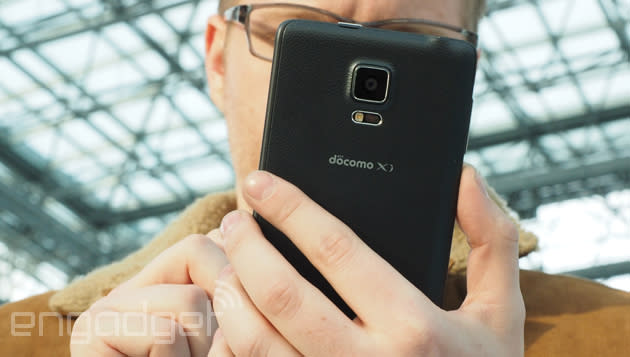
There's been no corners cut with regards to specifications -- fantastically, it goes toe to toe with the Note 4. It's the same high-resolution (2,560 × 1,600) screen -- we're certain a mere 1080p "Plus" curved display would have been cheaper to make -- as well as a 2.7GHz processor, 3GB of RAM and 32GB of storage (and a 64GB option), with a microSD slot for expansion. On paper, the only place that's been limited is the battery: a smaller 3,000mAh pack powers this special edition Note, compared to 3,220mAh in Note number four.
The stylus is another product of Samsung's collaboration with Montblanc: Multiple sensitivity levels and a nice grippy surface are the highlights. I'd point you to our Note 4 review for a closer look, but suffice to say that the stylus has turned into a real selling point for the Note series, with one caveat: There's a steep learning curve to using it. After using the Galaxy Note 2 for some time, the extra features and changes meant I came often unstuck at the start. My personal favorite, which I used a surprising number of times, was Image Clip, which allows you to copy and paste parts of your screen -- maps, parts of an image -- and save it for reference or use later. Combining my scraps with a messaging app was simplicity. The new pen even lets you batch select parts of text or even files and pictures -- yes, a real productivity tool!
One-handed use
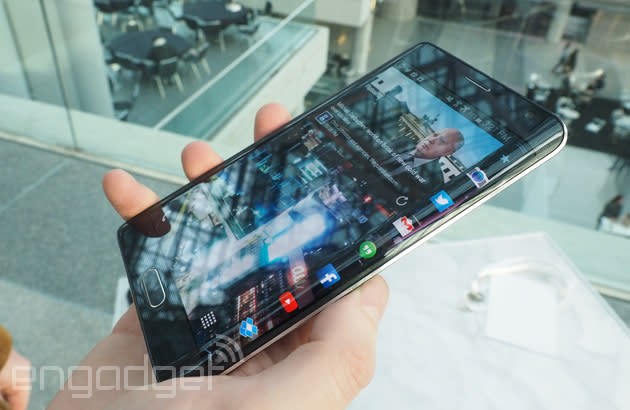
Disclaimer: Your hand is different from mine, but it seems only fair to do the same comparison we did for the Note 4. The Note Edge is wider than the Note 4, and although I've only spent a brief time with the latter, the curved, tapered side of the Note Edge seemed to fit rather snugly into the corner of my palm. I never found it uncomfortable, but please don't forget it remains a big phone. Both come with software tricks like shrinkable keyboards as well as a new, tiny floating menu that can be stuck to the outer edge of the screen. This duplicates the capacitive button row, which could be a solution of sorts for lefties. I can even make this secondary menu transparent, allowing me to maintain all that screen space. The ability to shrink the likes of Chrome and Google Maps to a popup window and layer it on top of other apps is also useful; I'd love to see something similar on the iPhone 6 Plus.
And how does Apple's biggest phone compare to the Note Edge? Well, both remain unwieldy to grip, and the Note Edge is wider. However, the edged screen nuzzles into my hand better and those software tweaks mentioned above give it the advantage. However, just like the stylus, there's a while before you get the knack of all the little provisions Samsung's made to ease users into this screen size.
Software
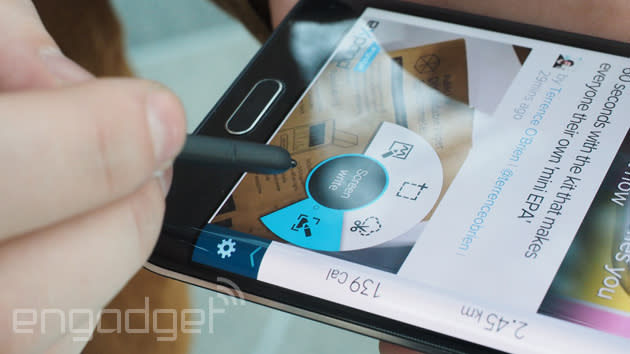
If you're looking to learn more about the stylus' uses, I'd advise a quick read of Brad's Galaxy Note 4 review, because the setup is identical here. Yes, there are TouchWiz bits running on Android 4.4 KitKat, but Samsung continues to clear away unnecessary bloat and options. It's still a work in progress, though, and I feel the settings menus are particularly obtuse compared to other Android phones -- and especially iOS. It takes some getting used to.
But let's focus on what's different here: that edge. There are two display modes you can flit between: a slender, unassuming bar that can display a customized message and a more substantial column that attempts to offer extra functionality, notifications or context-dependent menus for certain apps, like the camera. When it's expanded, the UI is a basic row of icons, which you can navigate with a little swipe. This may look a little unusual, but swishing through the various mini-screens (you can configure what it shows, and even install third-party "edges"), is immensely satisfying.
While you can cycle through up to seven edges (why the limit?), each can also be toggled off, so you could strip it down to simply a notification and app shortcut bar. Or you could keep seven different things there: weather, stocks, bizarre memory-matching game, your pedometer stats or a Japan-only navigation bar that'll offer traffic alerts and your nearest train station. Predictably, there's a way to go on these edge apps -- did Samsung not learn from those early wearables? The edge could be so much more useful with Spotify controls or a Gmail notification bar that offers more than just a number of unread emails.
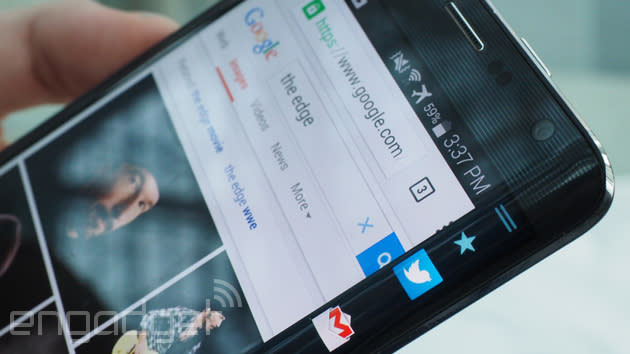
The edge of the screen also comes into its own when Samsung went to the effort to add dedicated menus. For the camera, this means your viewfinder isn't obscured, which is nice. Similarly, when playing video, you get the fullscreen playback, and tapping the screen brings up controls along the curved edge. Notifications will also appear here, which is a nice touch. However, app-dependent edge functions stop there, and the camera and video player both seem like the most useful scenarios for it.
I ended up using the edge screen differently. I felt like my apps belong better on the side, and customized the favorites edge to include all my regular apps like Chrome and Maps. Rather than squeeze as many of these vital apps onto a home screen (or two), I can house them on that swipeable side. The screen can then showcase wallpaper, or suitably pretty widgets. Apps are then not a button press, but a swish away. Samsung (and Apple) might not like it, but it reminds me very much of my Mac setup.
You can also turn the edge into a centimetered ruler. Not sure how much you're going to use that function -- I didn't use it once. Something I did like was the night clock setting, which, when it hits a certain prescribed time, will light up the edge with a simple clock readout.
These might be the best parts, but the marvel remains the technical accomplishment of the curved screen. The applications for it don't quite amount to enough -- at least right now. What does the edge lack? What do I want? I'm not even sure, but when text scrolls down the edge and you're facing the right side, the edge, of the phone, it's upside-down. If Samsung were to reverse it, then it'd be upside-down when you're using the thing. It's particularly frustrating for the Twitter widget, which scrolls through highlights.
Camera

Again, Samsung didn't cut any corners when it came to the phone's imaging prowess. The Note Edge packs a 16-megapixel camera, with Samsung's "smart OIS" intended to eke the light (and detail) in tougher lighting. The front-facing camera is also a top-end sensor compared to the competition, 3.7 megapixels with an f/1.9 lens. There's also a (bizarre-sounding) selfie mode that stitches a trio of pictures together for widescreen, "best friends!" capture -- when you have more than two BFFs.
While I'm not a huge selfie taker, you'll have to ask our Senior Selfie Editor, but I do take a whole lot of photos with my smartphone, so I was interested to see how Samsung's newest smartphone camera handled (yup, it's in the Note 4, too). Fortunately, I spent time with the Note Edge in Tokyo and New York: two places where sample photos can be done pretty much everywhere.
All told, it's an excellent camera. The image stabilizing works well on all the neon lights that pepper Tokyo, while even people were neatly captured. There's some noise, but it compares favorably against older Galaxy phones. Daylight meant effortless captures and some really nice shots, if I say so myself. Focus was swift, and auto white balance seemed to gauge scenes perfectly. If you have a proclivity for HDR, rest assured the Edge does an excellent job there.
Performance and battery life
Samsung Galaxy Note Edge | Samsung Galaxy Note 4 | Samsung Galaxy S5 | iPhone 6 Plus | |
|---|---|---|---|---|
Quadrant 2.0 | 23,861 | 24,425 | 24,714 | N/A |
Vellamo 3.0 | 1,882 | 1,808 | 1,656 | N/A |
3DMark IS Unlimited | 19,912 | 20,692 | 17,954 | 17,902 |
SunSpider 1.0 (ms) | 788 | 793 | 820 | 388 |
GFXBench 3.0 Manhattan Offscreen (fps) | 18.4 | 18.8 | 11.5 | 18.2 |
CF-Bench | 40,143 | 43,234 | 33,351 | N/A |
SunSpider: Lower scores are better. | ||||
It bears repeating: Samsung's treated the Galaxy Edge buyer to some of the best components underneath that curved display: 3GB of RAM to ensure multitask windowing runs smoothly, and a quad-core Snapdragon 805 processor to back it up. Like the Note 4, lag and slowdown simply didn't happen. However, there were the occasional hiccups where the edge widget would refuse to cycle to the next page. The only fix I found was to reset the phone. It's a shame, as it's a minor issue that stops the phone getting full performance marks.
The Edge goes toe to toe with the Note 4, because well, it's pretty much the same phone. But how about the smaller battery, one of the only hardware differences? With a little more screen resolution and less capacity on the cell, we feared the worse. Well, in our battery of... battery tests, it lies somewhere between the Note and Galaxy S series. It's not quite as good as the former, but better than the latter: A very heavy day of use (lots of maps, lots of photos) will tucker out the phone before bedtime. That said, in our video-loop battery test at half brightness, the Note Edge's 3,000mAh cell ran out after just over 10 hours. With more moderate use, the phone would arrive back at my house with around 20 percent left, enough to notify me that I needed to charge. The fingerprint sensor to unlock the phone is more sensitive and accurate than preceding Galaxy devices, although the heart rate sensor on the back of my Note Edge didn't seem to pick up my pulse at all. I wasn't dead, and a second Note Edge we picked up for testing did offer up readings swiftly inside the phone's S Health app.
The competition
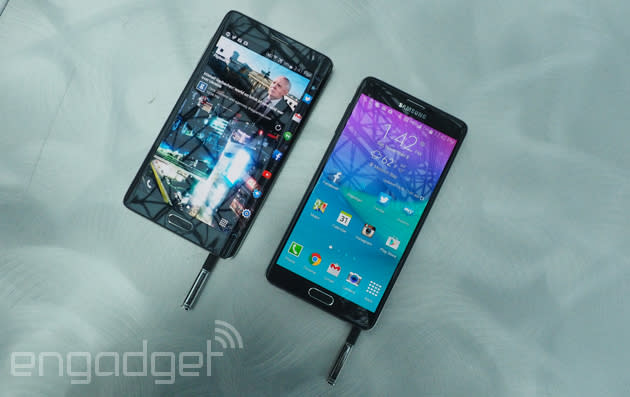
When it comes to big smartphones, we've never had quite as many strong options. What was once the domain of only Samsung and LG now has competition from Apple and even smaller upstarts like OnePlus. Samsung has launched the Note Edge mere months after its own Note 4, and the phones are identical in so many ways. The major difference isn't that the battery's smaller on the Edge, but the price: off-contract the Note 4 comes in at around $800. The Note Edge, meanwhile is priced at $950 -- just shy of 200 bucks more. On-contract pricing on AT&T comes to around $400, while the Note 4 and the iPhone 6 Plus ring in at $300. Apple's iPhone 6 Plus, lacking a stylus, but coming with the slicker iOS 8, starts at $750 off-contract for a 16GB model. Unlike both of this year's Galaxy Notes, however, you can't upgrade the storage -- something worth bearing in mind. Then there's the OnePlus One: a lower-resolution (but still gorgeous) 5.5-inch 1080p display, no stylus, no add-on storage, but you could buy three and have spare change for cases compared to the Galaxy Note Edge. It boils down to how much you want a stylus, and how much you're willing to pay for a phone that's not like anything else.
Wrap-up
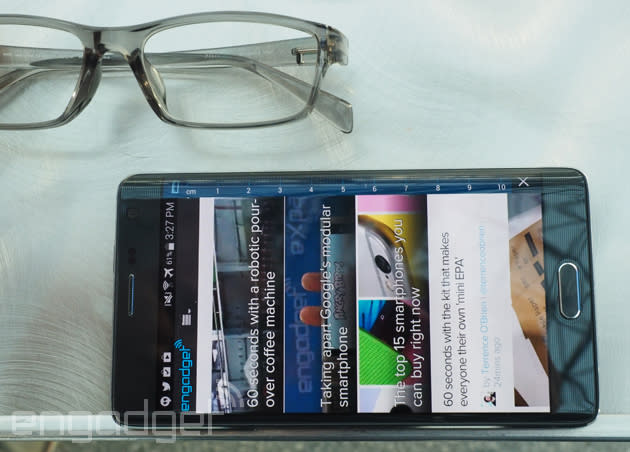
Is the Note Edge a gimmick? It's hard to say, but I don't think the curved display is a bad thing. The best part is that even without the edge, you've still got, for all intents and purposes, a Galaxy Note 4, with a stylus, power, long battery life and a capable camera. The more I used the Note Edge, the less the edge part seemed to matter: I'd use the shortcuts to apps from the edge, but gradually disabled most of the widgets. Pervasive uses for the curve aren't quite there. What did remain was how gosh-darn eye-catching the display was, augmented by that curved AMOLED glow. And if foldable smartphones and tablets are going to happen, if devices with more useful, innovative displays are to appear, phones like the Note Edge are the iterations that need to happen. If you liked any of the previous Galaxy Notes, or were at least intrigued by them, then the Galaxy Note Edge deserves the same amount of attention -- even if, at $980 off-contract, you're really paying for that progress.
Edgar Alvarez contributed to this review.









































